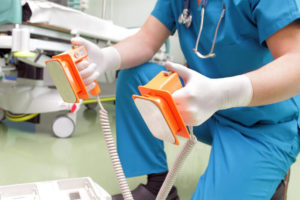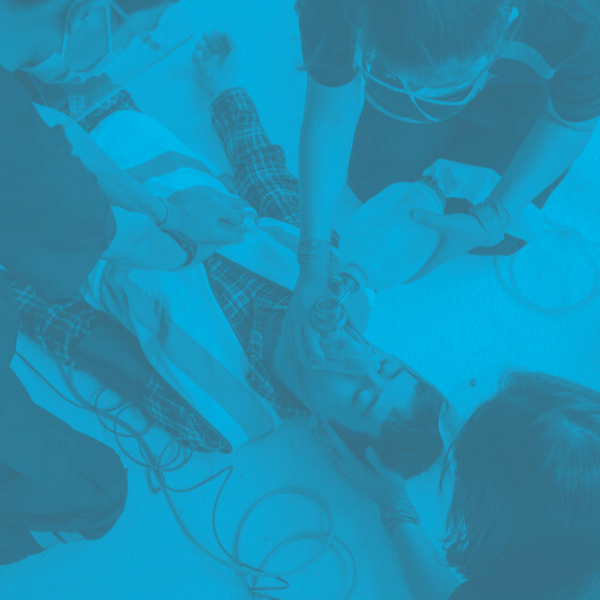Understanding the Basics of Synchronized Cardioversion
Understanding the Basics of Synchronized Cardioversion

by Greta Kviklyte
Life Saver, AMC
Co-authored by Kim Murray, RN, M.S.
posted on Jan 6, 2021, at 7:08 am
Cardiac arrhythmias are common but deadly conditions that affect patients both inside and outside the hospital. When this condition occurs, steps can be taken to reverse it, thus saving the patient’s life in many cases. However, the techniques used to treat cardiac arrhythmias vary and must be chosen based on the specifics of the patient’s situation. One of the techniques that may be used to successfully treat an arrhythmia is synchronized cardioversion. An overview of this technique and its use is provided below.
We offer Online ACLS Certification and Renewal
What Is Synchronized Cardioversion?
Synchronized cardioversion is a specific medical procedure used to restore a normal heart rhythm to a patient who is experiencing an arrhythmia, which is an irregular heart rhythm. During this procedure, a direct electric current passes through the patient’s chest, which shocks the heart. After this shock, the heart often may resume a normal rhythm. Synchronized cardioversion requires the direct electric current used to be synchronized with the activity of the patient’s heart.

When Is Synchronized Cardioversion Necessary?
Synchronized cardioversion is typically utilized in cases where a patient is experiencing an unstable tachycardia arrhythmia. This means that the patient will have an abnormal heart rhythm coupled with an increased heart rate.
Arrhythmias reduce the amount of blood the heart can effectively pump to important parts of the body. If left untreated, these conditions can cause serious and even fatal complications, such as a stroke or heart attack. For this reason, prompt treatment of a serious arrhythmia is essential.
Some of the conditions most commonly treated by synchronized cardioversion include:
- Monomorphic ventricular tachycardia
- Atrial tachycardia
- Atrial flutter
- Atrial fibrillation
- Supraventricular tachycardia
Are There Contraindications for Synchronized Cardioversion?
As long as a patient is experiencing one of the heart rhythms that indicates the use of synchronized cardioversion, this procedure can typically be implemented. There are no contraindications for this procedure, and it can be used even when the patient has a pacemaker or automatic implanted cardiac defibrillator. The presence of either of these devices should not impact the effectiveness of the synchronized cardioversion procedure.
How to Perform Synchronized Cardioversion
Prior to beginning the synchronized cardioversion procedure, it is important to make sure the procedure is actually necessary and that the chances of the patient surviving are as high as possible. Before the procedure begins:
- Review and identify the patient’s rhythm.
- Verify the patient’s rhythm with a 12-lead EKG if there are any doubts about the patient’s rhythm.
- Sedate the patient with intravenous medication to reduce pain during the procedure.
- Have emergency equipment on hand and available in case of complications. Be sure that you have access to a bag-mask device, suction device and airway management equipment.
- Shave any hair on the patient’s chest to accommodate the electrodes.
- Provide supplemental oxygen if required by the hospital.
The procedure begins after an IV has been placed and the sedation medication has been administered to the patient. Place the electrodes on the left side of the chest approximately two inches under the mid-axillary line. Place electrodes on the right side of the chest below the clavicle.
Once the electrodes are in place, press SYNC on the defibrillator machine. Verify that the machine is sensing and marking the R wave accurately by reviewing the rhythm strip. Otherwise, the shock may not be delivered at the appropriate time.
Choose the most appropriate energy level and make sure everyone else in the room is clear of the patient before you deliver the shock. Keep in mind that the delivery of the shock may not be immediate, as the machine must administer the shock at the appropriate time for the patient’s current rhythm.
Following the first shock, it is necessary to reassess your patient’s rhythm to see if it has returned to normal. If the patient’s rhythm has not returned to normal, you will need to administer a second shock. Because machines return to their default mode of defibrillation after administering the first shock, be sure to press SYNC again before administering the second shock. As with the first shock, you should make sure the machine is measuring the rhythm accurately. Clear the patient and administer the shock. Throughout cardioversion, be sure to monitor the patient’s vital signs and consciousness level. Even after a normal rhythm begins, you should continue to monitor vital signs and consciousness level until the patient is fully awake and stable.
Anticipating Complications during Cardioversion Procedures
Many cardioversion procedures will be completed without any complications. However, in some cases, complications may occur. For this reason, it is important to understand the possible complications and prepare to respond to them. Some of the most common complications of synchronized cardioversion include loss of pulse and ventricular fibrillation.
The response indicated in these cases will depend on the specific type of complication. For example, in cases where a patient who has unstable supraventricular tachycardia loses pulse, the best treatment is implementation of the ACLS algorithm for pulseless electrical activity. If a patient with an unstable ventricular tachycardia loses pulse during synchronized cardioversion, the best treatment is implementation of the ACLS algorithm for ventricular fibrillation. Finally, if the patient develops ventricular fibrillation during treatment with synchronized cardioversion, the defibrillator should be taken out of “synchronize” mode so it can be used for defibrillation.
If a patient is not breathing properly on their own, manual ventilation may be indicated as well.
Making Necessary Adjustments
In an ideal situation, the synchronized cardioversion procedure works seamlessly and the patient resumes a normal rhythm without complications. However, in some cases, you may need to make some adjustments to the procedure in order to make it work properly.
Below are some tips that may improve the success of synchronized cardioversion.
- Make sure electrodes are placed in optimal locations.
- Adjust the amplitude if the machine is not sensing the patient’s rhythm accurately.
- Apply the appropriate force when delivering the shock to maximize the effectiveness of the current.
- Monitor the patient continues to see if further adjustments or changes to the treatment plan are indicated.
Comparing Synchronized Cardioversion to Defibrillation
It is important to remember that synchronized cardioversion and defibrillation are not the same things. Defibrillation involves the delivery of a high energy shock to the heart. This procedure does not require you to deliver the shock at any specific time in the QRS complex. Synchronized cardioversion, on the other hand, involves the delivery of a low-energy shock at a specific time in the QRS complex. This means that careful preparation and synchronization is required when performing synchronized cardioversion, but not when performing defibrillation.
The purpose of synchronizing the shock delivered in synchronized cardioversion is to avoid causing a complication. For example, when a patient with atrial fibrillation undergoes synchronized cardioversion, the shock will be delivered at the best moment to convert the patient back to a normal sinus rhythm. Delivering the shock during the vulnerable wave on the QRS complex would instead lead to ventricular fibrillation.
Defibrillation is typically used when a patient’s rhythm is so unstable that no apparent QRS complex can be seen, which means there is no vulnerable wave or point in the complex to avoid. Defibrillation is commonly used to treat pulseless ventricular tachycardia and ventricular fibrillation, while synchronized cardioversion is more commonly used to treat other rhythm problems.
Although there are key differences between these two treatments, they do share a similarity. Bot defibrillation and synchronized cardioversion deliver a therapeutic dose of electrical energy to the myocardium. Nonetheless, understanding when each of these treatments is indicated is essential to avoid causing unnecessary complication and to maximize the likelihood of returning the patient to a normal sinus rhythm.
Who Needs to Know How to Perform Synchronized Cardioversion?
Patients can develop the rhythm problems that necessitate synchronized cardioversion can occur inside or outside of the hospital, and this technique can be used in either setting. Because it has been shown to save lives, it is important for all healthcare professionals to understand synchronized cardioversion and possess the skills necessary to perform it.
Synchronized cardioversion skills can be beneficial to nurses, doctors, pharmacists and emergency medical personnel.
Where Can You Learn How to Perform Synchronized Cardioversion?
Reading about the purpose and use of synchronized cardioversion is not sufficient to prepare healthcare professionals to use this procedure. In order to ensure that you are ready to perform synchronized cardioversion in a clinical setting, formal training is highly recommended. In fact, some employers may require you to have training in this technique.
The best way to learn how to perform synchronized cardioversion is to enroll in a course that includes this type of training. For example, Advanced Cardiac Life Support training often covers synchronized cardioversion. You may be able to find Advanced Cardiac Life Support courses from a variety of sources, giving you plenty of options to choose from when it comes to getting the education you need.
For the best results, it is important to consider several different factors as you compare ACLS programs. Some of these factors include:
- The structure of the program. – Different ACLS program structures are available, including in-person programs, online programs and hybrid programs conducted both in person and online. Different program structures may be more appealing to you based on your own goals and preferences. For example, if you would rather complete your ACLS program from the comfort of your own home while learning at your own pace, you may opt for an online program.
- The program’s reputation. – One of the most important things to consider when comparing ACLS courses is the reputation of the program in question. Be sure to investigate reviews from past students, as well as the general reputation of the company offering the course. Gathering this information will help you decide whether the program will be effective, affordable and easy for you to complete.
- The certification provided. – Most people who are enrolling in an ACLS program are hoping to walk away with a certification that will be accepted by their employer. Before you begin any ACLS program, make sure the program ends in a certification that will satisfy your employer’s requirements.
- The convenience of the program. – When you work in a busy, high-intensity profession like healthcare, convenience is always important. Look for a program that offers the conveniences that matter most to you. For example, at Advanced Medical Certification, we provide our students with a digital copy of their certification card as soon as they pass the ACLS exam. For students who need to turn in evidence of certification as quickly as possible, this is a highly valuable benefit.
- Affordability – If you are not being reimbursed by your employer for the cost of your training program, you may also consider the price. However, it is always essential to prioritize program quality over expense.
The Importance of Continuing Education
Synchronized cardioversion is a complicated procedure that must be performed accurately in order to ensure the best chances of success. For this reason, studying the procedure only one time is not recommended. Even after you have studied synchronized cardioversion and obtained the related ACLS certification, it is still important to review these skills on a regular basis. In fact, most employers will require you to obtain an updated certification at regular intervals to show that you still possess the necessary knowledge and skills. Learning more about synchronized cardioversion and other important life-saving procedures through additional independent study can also be helpful to medical professionals, even if it is not a requirement to remain employed.
Have you learned something new? If yes what is it? Please share with us.




Thank you for breaking down the concept of synchronized cardioversion! The explanations were clear and easy to follow, especially for someone like me who is new to this topic. I appreciate the emphasis on the safety protocols involved. Looking forward to more posts like this!
This was a really insightful post! I appreciate the clear explanation of synchronized cardioversion and its importance in treating arrhythmias. It helped me understand the procedure better and its role in managing heart rhythm disorders. Thanks for sharing!
This post really clarified the process of synchronized cardioversion for me! I appreciate the detailed explanations and the emphasis on the importance of timing. It’s fascinating to see how such a precise procedure can make a significant difference in patient outcomes. Thank you for breaking it down so well!
This post does a great job explaining synchronized cardioversion! I appreciate how you broke down the process and its importance in treating arrhythmias. It’s crucial to understand when this procedure is needed and how it works. Thank you for making this complex topic more accessible!
This post did a fantastic job breaking down the complexities of synchronized cardioversion! I appreciate how it explained the procedure’s purpose and the importance of timing. It made the topic much more approachable. Thank you for sharing this valuable information!
Thank you for breaking down the process of synchronized cardioversion in such an understandable way! I really appreciated the clear explanations of its indications and safety measures. This definitely helped demystify what can often seem like a complex procedure.